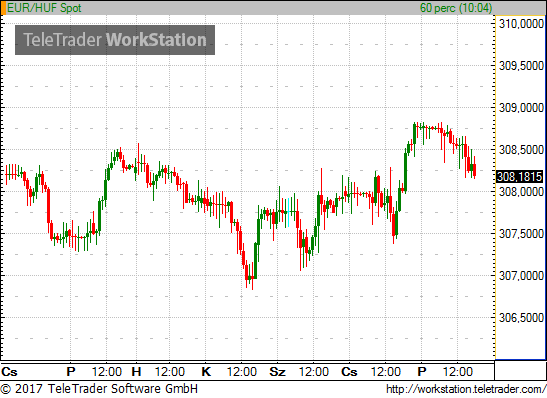S&P leaves Hungary's debt rating unchanged
Overview
- S&P expects Hungary's real GDP growth will pick up slightly to about 3.0% in 2017 before moderating to just under 2.5% on average between 2018-2020.
- The rating agency believes Hungary's sizable current and capital account surpluses are supporting the economy's continued deleveraging.
- It has therefore affirmed its 'BBB-/A-3' sovereign credit ratings on Hungary.
- “The stable outlook reflects our assessment of Hungary's strong external profile, and modest fiscal deficits, against its high levels of public debt, and moderate long-term growth prospects," S&P added.
The forint did not react to the non-decision and remained around 308.30 to the euro.

Rationale
“Hungary's substantial external surpluses and its track record of fiscal restraint support the sovereign ratings. Moderate long-term growth prospects, high public debt, and an impaired monetary transmission mechanism are key constraints on the ratings."
S&P believe that real GDP growth for 2017 will approach 3%- due to the wage agreement initiated by the government in late 2016, which implies higher private sector minimum wages in exchange for a lower payroll tax burden;
- its expectation of recovery in EU fund absorption;
- fiscal stimulus measures, including value-added tax (VAT) cuts on dwellings, a reduction in the banking tax, and rising expenditure on housing subsidies;
- real wage and employment gains; and
- stronger private sector balance sheets.
Over the medium term, however, the rating agency expect Hungary's underlying fundamentals - namely poor demographics, worsened by net emigration, low labor participation, a large and encroaching public sector, as well as weaknesses in the business environment, low productivity, and an overheating labor market - will slow the pace of average GDP growth to just under 2.5% per year between 2018 and 2020.
S&P expects Hungary’s growth to accelerate only to 2.9% this year (it has 2.0% in its table for 2016), then slow down to 2.5% in 2018 and stay there in 2019 only to drop further to 2.4% in 2020. This is a much more pessimistic projection than the government’s own, which has 4.1% growth pencilled in for this year, 4.3% for 2018, 3.8% for 2019 and 3.7% for 2020.
Monetary transmission channel remains hampered
“While we believe that the 2015 foreign currency household loan conversion was an important step in reducing the euroization in Hungary's financial sector, we continue to consider that Hungary's monetary transmission channel remains hampered due to:- i) Still substantial dependence on nonresident financing;
- ii) The sizable remaining, albeit recently declining, stock of legacy nonperforming loans (NPLs; domestic loans more than 90 days overdue) in commercial real estate; and
- iii) Residual dependency on foreign currency financing for Hungary's banks.
“Only very recently has there been evidence of a recovery in private credit growth, primarily to the small and midsize enterprise (SME) and household sectors, also reflecting the introduction of central bank programs (for example, the Funding for Growth Scheme and the more recent Market-Based Lending Scheme)."
For 2017, S&P forecasts that credit growth will be positive after it shrank in 2011-2015.
Fiscal slippage will be negligible
“Despite the government's intentions to continue its fiscal stimulus via tax cuts and higher spending in the 2017 budget, in our base case, we assume that, going forward, fiscal slippage will be negligible, resulting in general government deficits of 2.3% of GDP on average in 2017-2020," S&P said.“This is despite a potentially wider fiscal deficit in 2017 ahead of the 2018 parliamentary elections compared to the 1.3% of GDP general government deficit in 2016, which was supported by asset sales and strong consumption tax receipts," it added.
S&P forecasts that general government debt, net of liquid assets, will reduce gradually to about 65% of GDP in 2020 from 70.7% in 2016.
The rating agency noted improvements in Hungary's central government debt profile, adding that concentrated policy efforts have yielded a reduction in Hungary's foreign currency-denominated debt to about one-quarter of total outstanding debt.
S&P also noted that Hungary’s general government interest costs dropped to about 6.6% of general government revenues in 2016 from its peak of nearly 10% in 2012.
We project that the Hungary's debt-servicing costs will decrease further over the forecast horizon, supporting the ongoing improvement in its debt profile.
There are risks
“Our fiscal forecast does not factor in any contingent risk, such as capital injections into development institutions, new state acquisitions, and/or spending on visible capital projects, especially ahead of upcoming parliamentary elections in early 2018."
“If these developments crystalize, they might place downward pressure on the government's fiscal and debt profiles. Such risks are underpinned by what we regard as relatively limited predictability and stability of policymaking, which results from only moderate checks and balances between government branches," S&P added.S&P also warned that “higher global energy prices, strong domestic demand, and growing wages will likely reduce current account surpluses to below 2% of GDP in 2020 from the exceptionally strong level of 5% in 2016."
It added, however that “this will likely be counterbalanced by other non-debt inflows, primarily EU funds via the capital account. This will result in a continued reduction of our preferred external debt measure, narrow net external debt, which has more than halved from its peak levels in 2009."
Citing high core inflation at 1.4% in 2016, S&P assumes that “rising energy prices, stronger domestic demand, and expected minimum wage hikes will likely push inflation toward the MNB's target already in 2018."
Banking system still weak
“A relatively weak monetary transmission channel remains a challenge for the central bank as the banking system is still weak."
S&P currently classifies Hungary's banking sector in group '7' under its Banking Industry Country Risk Assessment (BICRA) methodology ('1' is the lowest risk; '10' the highest).“Our BICRA assessment of Hungary reflects the sector's high exposure to the commercial real estate and construction sectors, weak profitability, and high levels of NPLs, which by our estimate constitutive over 10% of total domestic system loans, excluding loans to foreigners and to the financial sector."
S&P noted that with the objective of clearing banks' balance sheets of bad loans related to commercial real estate and project finance, the MNB set up MARK Zrt, an asset management company (commonly known as a "bad bank"). MARK was set up with a EUR 1 billion (about 1% of GDP) loan from the central bank. We include this loan in our calculation of Hungary's gross and net general government debt from 2016.
Outlook
The stable outlook reflects our expectation that Hungary's continued cyclical recovery and its contained headline fiscal performance will support a gradual reduction in general government debt. The outlook also factors in our assumption that the economy's current account balance will stay in surplus, supporting Hungary's strong external balance sheet.
S&P said it could raise the ratings- if government debt declines faster than we project and/or
- if we observed a further reduction in sovereign debt-servicing costs, or
- if the transmission of monetary policy improves (for example, via a more concerted reduction in legacy NPLs in the commercial real estate sector).
The ratings could come under pressure
- if Hungary's public finances weakened materially,
- if S&P were to expect a sustained reversal in the declining debt-to-GDP ratio,
- if contingent liabilities rise rapidly, or
- if external vulnerabilities build up again contrary to S&P’s current expectations.
- if S&P saw the transparency of key institutions weakening further, especially
- if the rating agency anticipated an eventual fiscal risk associated with such weakening.









